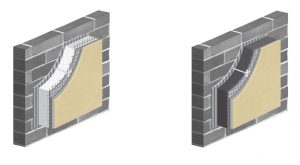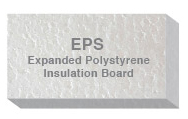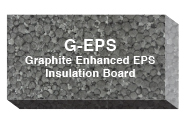
Terraco’s bestselling EIFS Alpha system, often specified by architects and consultants alike for new and renovations projects, uses EPS (Expanded Polystyrene) as the insulation material.
The principal reason for Terraco EIFS utilising EPS / G-EPS is because it is typically the most cost effective board used today, while Graphite enhanced (G-EPS) offers 10% more thermal efficiency and is suited to renovation work as thinner sections can be used.

EPS board G-EPS board
View the EIFS Alpha Video below:
INSULATION MATERIAL
To determine the thickness of the insulation material required in your Terraco EIFS System you need to determine the Thermal Resistance (R) value required to achieve the required U-Value. The lower the U-Value, the better insulation and performance you get from the system.
Terraco EIFS uses insulation materials with low thermal conductivity (λ) to get low U-values and reduce thermal bridging.
| Insulation Board | Thickness (mm) | Thermal Conductivity K-Value [W/(m.K)] |
Thermal Resistance R-Value [(m².K)/W] |
Thermal Transmittance U-Value [W/(m².K)] |
 |
50 100 150 200 |
0.033 | 1.52 3.03 4.55 6.06 |
0.66 0.33 0.22 0.17 |
 |
50 100 150 200 |
0.030 | 1.67 3.33 5.00 6.67 |
0.60 0.30 0.20 0.15 |
SYSTEM COMPONENTS
The EPS is fixed to the substrate using a combination of adhesives, mechanical fasteners, reinforced with a basecoat and glass fibre mesh, and finished with a decorative wall coating, referred to as system components.
The Terraco Alpha System consists of the following system components:
| ALPHA SYSTEM | ||
| Product Name | Description | |
|
Standard Components
|
||
| Terraco Styrofix | An adhesive used to fix the EPS to the substrate. | |
| EPS / G-EPS Insulation Board |
The insulation material thickness is determined by the thermal performance required. | |
| Mechanical Fasteners | Plastic fasteners with plastic or steel pin dowels are used to fix the EPS to the substrate, which also assists with wind shear at higher levels. | |
| System Profiles | A range of accessories required for strengthening and finishing the system – for finishing around window and door openings, and window sills. | |
| Terraco Styrobond DP | The basecoat that is reinforced with a layer of EIFS Glass Fibre Mesh. | |
| EIFS Glass Fibre Mesh | A reinforcing EIFS Glass Fibre Mesh. | |
| Primer | A basecoat substrate penetrating primer – Terraco P Primer. | |
| Decorative Finish | A high performance, decorative wall coating which is sometimes finished with a clear or pigmented top coat. | |
TECHNICAL DRAWINGS
The following EIFS technical drawings are available for Terraco EIFS Alpha System:
These drawing are for reference purposes only and can be availed by contacting the Terraco Representative closest to you for assistance.
ARCHITECTURAL DETAILING
Another benefit of EIFS is the option to add architectural detailing that are composed of the same materials. EIFS mouldings, or as they are sometimes referred to stucco mouldings, come in a large variety of shapes and sizes. They are traditionally formed using EPS / G-EPS and are widely used on residential or commercial projects to allow architects to stylise the particular building. Please consult with your Terraco representative in this regard, as production methods allow manufacturers of the insulation materials to create mouldings and other shapes and forms with great efficiency in a cost effective manner, and as the architectural drawings do not show this type of detailing as this is done on a project to project basis.
INSTALLATION
The installation of Terraco EIFS needs to be done by an Approved Terraco EIFS Applicator to ensure the validity of the Terraco International EIFS Guarantee. The installation process is fundamental to achieving the best possible results from Terraco EIFS, and failure to follow these requirements could lead to problems with the system or ultimately failure of the system itself.